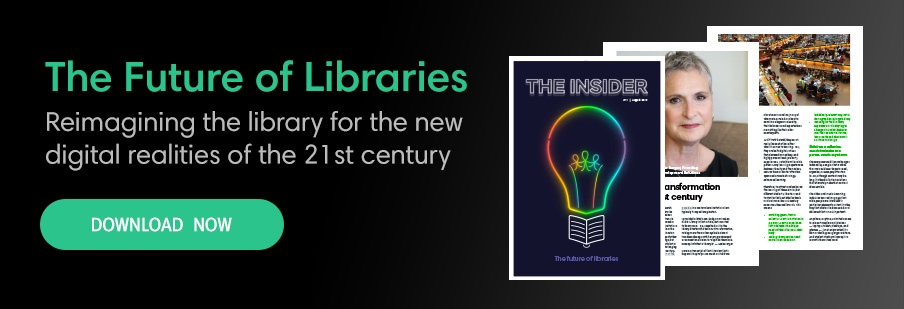Imagine waking up one morning and finding that your public, school, or academic library had disappeared overnight — literally vanished.
No building, no resources (physical or electronic), and no people to help you discover, learn, and use information to improve our lives, knowledge, and businesses.
It would be like being transported into the pages of Fahrenheit 451 where ignorance over knowledge was the road to an “equalized” society. Makes me shiver just thinking about it.
Now I realize this is just a bad dream — a nightmare that has no basis in fact. But when I look at what’s happening in this era of budget cuts, library closures, and fake news’ impact on information literacy, it’s not that hard to wonder if libraries are facing a dystopian future.
Being an optimist, I still believe there’s time to save an industry which would devastate humanity if it were gone.
But, and this is a big but, it’s also true that the only ones who can save libraries are the libraries themselves. Associations can help guide them, but in the end, each library must take responsibility for keeping its doors open, its lights on, and its products and services available and relevant for its community.
To thrive in a world racked by constant and accelerating change, libraries need to rewrite themselves for a sustainable future most of us can’t even imagine yet.
The Great Rewrite is here
When one looks back at hundreds of years of media innovation, it historically consisted of inventions such as the Gutenberg Press (and movable type), recorded media, radio, the telephone, and television.
These inventions, while impressive at the time of conception, were fundamentally much the same:
- They broadcast content on a one-to-one or one-to-many basis
- They were technologically very expensive to build
- They were all regulated by governments
But when the web was made publicly-available in 1993, people suddenly owned a many-to-many communications network, where millions of us could communicate with millions of others for almost no cost. The internet gave us a new, democratized form of media that is virtually impossible for governments to regulate.
So what’s so important about that? Well, according to serial entrepreneur, venture capitalist, and best-selling author, Leonard Brody, it is this phenomenon that is fueling the massive changes we are experiencing in business and society today.
Our planet is being rewritten from the ground up — a complete reboot of the largest era of mass institutional change in the history of the world. No industry is exempt.
Libraries, education, media, travel, finance, and healthcare, to name just a few, are all feeling the effects of this phenomenon.
Why? Because it all comes down to power. Before the internet, power/authority was controlled from the top-down, whether that be from presidents, principals, priests, or publishers. Fueled by massive changes in technology and social behavior, that traditional pyramid of power has been completely inverted in almost every facet of our lives.
Edelman research supports Brody’s premise stating that there has been a fundamental shift in the relationship between those who traditionally held authority and the people they once controlled.
We live in a people-powered planet with a younger generation possessing that power their entire lives. And they aren’t prepared to give up any of it because it gives them authority their parents never had – a power that makes them question everything and examine more closely the world around them through a new, more critical lens.
Leadership in our rewritten world
They say that being a leader is one of the loneliest jobs in the world. It’s particularly challenging when their organization is struggling to survive in our upside-down world — a world where “it’s all about me” generations expect no less than a highly personalized experience in every transaction and interaction with a brand.
And despite what you might think, a library is a brand, and it needs a 21st-century leader willing to discard the shackles of bureaucracy and lead by serving.
Best-selling author and management guru, Gary Hamel, said that many brands suffer from a “clutch of core incompetencies” which stem from the tenants of bureaucracy.
“Strategy gets set at the top. Power trickles down. Big leaders appoint little leaders. Individuals compete for promotion. Compensation correlates with rank. Tasks are assigned. Managers assess performance. Rules tightly circumscribe discretion.
“This is the recipe for ‘bureaucracy’, the 150-year old mashup of military command structures and industrial engineering that constitutes the operating system for virtually every large-scale organization on the planet.”
He goes on to say that within a bureaucracy, bold thinking and action are not encouraged and old assumptions are only questioned when the organization hits a wall. Does this sound like your library?
It’s time for every library to break down the tenets of bureaucracy and embrace an entrepreneurial mindset committed to innovation.
It needs to change its management structure and culture in ways that will be, without a doubt, foreign and prickly for some.
Libraries must actively embrace change to fuel new ideas, diversify products and services, think and experiment outside the box, and look for new ways to monetize its assets and talents.
Library staff needs to become less isolated and gain new perspectives of the world around them. They must be willing to learn from those industries outside of their discipline that also faced potential extinction, but were fearless enough to raze the old to raise the new.
They must take responsibility for their future and accept the fact that funding is not a right; it’s a gift.
They need to rewrite their “library speak” to align with a new vision. They need to replace “fundraising” with “income generation” to remind themselves and others that they are in business to invest in their community and the sustainability of their future.
No business, organization, or institution in the 21st century can repeat the past and expect a better future. Libraries must think like a brand, act like a brand, and market its value as successful brands do.
It’s a massive undertaking to reinvent legacy institutions and lead them out of confusion and into a future of clarity and confidence, but in the end, the rewards will be worth the challenges.
Diversify to create new revenue streams
I started thinking about other industries that face the same challenges as libraries and the most obvious one was the publishing industry — specifically newspapers and magazines.
In the 20th century, consumers were more than ready to pay for daily delivery of their local paper because they saw value in the product. But when the web became mainstream, publishers gave away their journalism for free, expecting that digital advertising would cover the costs just as print advertising did for decades. They were wrong.
With the exception of Norway and Sweden, 20% or less of the global population are willing to pay for the same content in digital form. Why?
Because publishers had taught readers for years that digital content was free, and as much as they try to put the toothpaste back in the tube through advocacy campaigns and paywalls, consumers haven’t changed their behavior. They’re not buying it.
For the past 15 years, I've been saying that survival of mainstream media depends on revenue diversification. Advertising and reader revenue alone will never sustain the industry. Period. Full stop.
A number of publishers have seen the light and are finding success through diversification and investing in content repackaging, member communities, e-commerce, and brand licensing. Others are reaping rewards that come with live events and other experiences people are willing to pay for.
In the library space, patrons have also been taught that resources are free, so trying to charge for access now would be a waste of energy and time. It also goes against libraries’ view that access to content should be free.
But why does everything have to be free in a library? It doesn’t and it shouldn’t. Charging for ancillary services isn’t a sin, it’s a survival mechanism, and thankfully, some libraries are starting to realize that.
Most libraries charge fees for things like passport processing, printing, scanning, and digitizing. This is all great, but none of these are big-ticket items that could bring in the much-needed cash libraries need now.
Many already rent out rooms and venues to businesses and individuals to host events or create co-working spaces. But most of these rooms are limited in design, technology, and aesthetics.
Why not take that up a notch and offer premium workspaces more comparable to WeWork — a business that is booming. This will mean downsizing the physical resource area to make room, but that’s going to happen eventually anyway as digital takes over. Be proactive rather than reactive to digital transformation.

Speaking of renting, why not rent out original art, musical instruments, small office equipment, and karaoke machines?
How about making room for a coffee shop, a restaurant, or other alluring consumer businesses to attract more users and make money at the same time - sustainable income that can fund additional library services or staff hires? How about adding a kombucha-on-tap bar to the common space?
Why not offer historical tours for history buffs and organize city tours or live experiences for visitors, ala Airbnb Experiences? Research shows that people are much more willing to pay for experiences than things, and who would a stranger trust more for a truly local experience than a local library?
Librarians have a vast amount of expertise in many areas which could be leveraged better. Why not offer custom research, tutoring, or special classes for a fee?
Why not encourage patrons to be more sustainable and use public transit by charging for parking?
Why not offer different levels of paid and free memberships determined by the costs to deliver different services? Some libraries already do this. I don’t know how your library would want to segment its membership levels to suit its diverse community, but it’s worth thinking about.
Those are just a few thoughts; I’m sure with a good brainstorming session you could come up with more.
To inspire you, take a look at how a couple of the more progressive libraries have diversified themselves.
Johns Hopkins University
By moving beyond being recipients of institutional funding to being what Gary Hamel calls a “resource attractor”, Sheridan Libraries of Johns Hopkins University are rewriting themselves — embracing entrepreneurship and revenue diversification and launching projects designed to bring in outside dollars while still advancing their core mission.
The university is fostering an environment where risk-taking is encouraged — the antithesis of a bureaucratic hierarchy. Employees are encouraged to not only consult on projects, but submit their own proposals for new revenue-generating projects. They also get compensated when their ideas are chosen for implementation.
As Hamel said in Bringing Silicon Valley Inside, “If an idea has merit, it will attract resources, in the form of venture capital and talent. If it doesn’t, it won’t.”
Princeton Public Library
Princeton Public Library, founded in 1812, started rewriting itself in the early 2000s when it saw its stacks of printed resources being replaced by web searches and online reference sites. They saw book stores going out of business and knew that a similar fate awaited them if they didn’t change themselves to accommodate a new generation of users.
In 2004 they opened their doors to a new modern library with a café (many thought was insane during the planning stages), a used bookstore, community room, and quiet zone.

They gave today’s generation a more livable space, with resources organized in a way that made sense to patrons, not to the librarians who were used to the Dewey Decimal system. The library transformed itself into a gathering place with entertainment, events, and language classes.
Amenities include a science and technology lab, special exhibits, children spaces, literacy areas, a STEAM studio, and a nursing room. But what really sets them apart are the premium workspaces they have with state-of-the-art technology, a business center, and special rooms for meetings, study and conferences – rooms that attract non-profit and business revenues.
“You’ll see people starting businesses in our study rooms that are created specifically for co-working. Companies are founded here all the time.”
Brett Bonfield
Princeton Public Library Director (2016-2019)
Your future is in your hands
Best-selling author, Neil Gaiman said, “Libraries are our future – to close them would be a terrible, terrible mistake – it would be stealing from the future to pay for today which is what got us into the mess we’re in now.”
He’s right. But right doesn’t pay the bills.
Which is why I encourage you to diversify your funding sources to include commerce. Offer unique products and experiences that feed a patron’s passions and needs – things that they can't get anywhere else but through you. Things that they are willing to pay for.
This means hiring new people who know how to market and sell - how to make real money that can fund a more sustainable future.
Back in 1998, Dr. Dagmar Jank, first vice-rector of FH Potsdam in Germany, recommended that income generation training should be part of the formal library studies curriculum. I decided to do a quick search of the top graduate schools for library and information studies in the US to see if they offered this in their curriculums.
I started with the University of Illinois which ranked as No. 1 in the field. When I checked out their Master of Science and Library Information Science learning outcomes, there was no mention of income generation education.
The same was true at the No. 2 ranked school - the University of Washington. I stopped searching after that. If you know of any schools that do include courses in revenue generation for libraries, I’d love to hear from you.
The commitment to innovate is tough because it requires a lot of courage to raze the old to raise the new, not only in terms of business model changes, but cultural transformations as well. However, that doesn’t mean one needs to start from scratch; it means reinventing what already exists into something better.
Steve Jobs was a master of reinvention. He didn’t invent the technology that turned Apple from a company on the verge of bankruptcy in 1998 into one worth over US$100B in 2011. He reinvented what already existed at Apple and its competitors.
By focusing on user experience, Steve Jobs reinvented computers, phones, cameras, tablets, music, software, and more. He changed the industry and our lives.
If the number one risk to your library is your reluctance or fear to innovate, remember what Steve Jobs said, “Innovation has nothing to do with how many R&D dollars you have. When Apple came up with the Mac, IBM was spending at least 100 times more on R&D. It's not all about money. It's about the people you have, how you're led, and how much you ‘get it’”
How much does your library “get it” and what is it doing about it? I would love to hear your thoughts. Let’s talk!
This article was originally published in The Insider Magazine.









